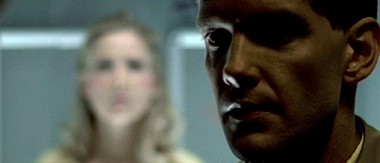
Jesper Just, Bliss and Heaven, 2004 DVD, 07:30 min. Courtesy Galleri Christina Wilson, Copenhagen
The 1st at Moderna: Jesper Just
Something to Love
1.1 2006 – 22.2 2006
Stockholm
Using the aesthetic, dramaturgic and narrative language of classic Hollywood productions, Just manipulates the visual codes, clichés and idiom of musical comedy, film noir, and melodrama in order to create short films that are sentimental, nostalgic, melancholic, theatrical and filled with Hitchcock-like suspense. His narratives are linear and easy to follow but the action appears to be taken out of a larger context. There is no past and no future, only a cryptic present that remains unexplained and unresolved. Leaving us spellbound, Just trusts us to draw our own conclusions.
Bliss and Heaven opens with a young man walking through a cornfield towards a remote power station. A truck pulls up and a pony-tailed driver gets out looking every inch the greasy trucker. He walks around to the back and climbs inside. The young man follows him. Inside, the trailer is transformed into a sumptuously grand theatre. The driver is on the stage wearing a long blond wig and a wispy white scarf, performing the Olivia Newton-John song “Please Don’t Keep Me Waiting”. The young man sits down to enjoy the show. At the end of the song, the driver staggers and falls to his knees as if in anguish. Curtain. Has he become aware of his singular audience? Was this a performance or a private act, revealing a secret life? The young man rises to a lonely standing ovation but there is no encore.

Jesper Just
Something to Love, 2005
Courtesy Galleri Christina Wilson, Copenhagen
DVD, 08:10 min
The atmosphere is dark, quiet and slightly sinister in The Lonely Villa. Suddenly the silence is broken by the shrill sound of a telephone. The camera reveals a group of middle-aged men sitting in front of telephones. Someone dials and an older man answers. A young man starts to sing the Inkspots’ “I don’t want to set the world on fire” into the receiver. The older man joins in and they perform a duet over the phone although they are in the same room. Their facial expressions are impassive and impenetrable. The next shot shows us the telephone with the receiver off the hook – the young man is nowhere to be seen.
In Something to Love an eerily deserted underground car park immediately conjures up visions of clandestine meetings. A black car comes into view driven by a crying middle-aged man; this could be a scene from an episode of the Sopranos. A young man sits in the back. Ignoring the driver, he stares impassively out of the window. The car stops. Are we about to witness a gangster-style execution? Who is the hitman – the driver or the passenger? The driver opens the door for the young man, who, surreally, glides away as if on invisible wheels to a lift. The older man runs after him. As he opens the lift door it is as if he opens a musical box. The young man is kissing a blond girl, both pirouette slowly, accompanied by the sound of tinny music. Suddenly, the girl opens her eyes and sees the older man. The young man stares at the older man for a few seconds, then leaves the girl and walks back to the car with the older man. He gets into the front passenger seat and the car slowly moves away.
In many of Just’s films the exact nature of the relationship between the men (often of different generations) is not revealed, only hinted at. It could be homoerotic attraction, father-son affection, or a power struggle between the generations? Just provides no answers, but leaves room for personal interpretation and critical reflection.
With the exception of Something to Love and A Fine Romance, there are no women in Just’s filmic world just as there is usually no spoken dialogue. Like in a Hollywood musical communication takes place through song and dance, and seemingly spontaneous actions. Hollywood has also to a great extent influenced our collective consciousness and our understanding of the relations between the sexes and the portrayal of masculinity and femininity. Just deconstructs this ideology by playfully disrupting filmic clichés and social conventions in order to challenge taboos of men’s stereotypical behaviour. In his films, men are emotional, tender and vulnerable, they cry, and instead of resorting to violence they sing and dance.
In this sense, Just’s films may be considered feminist in that feminism is concerned with the recognition of gender as a social construction, and not merely preoccupied with the problem of sexual equality. Judith Butler states in Gender Trouble: Feminism and the Subversion of Identity that, “There is no gender identity behind the expressions of gender; … identity is performatively constituted by the very ‘expressions’ that are said to be its results.” In other words, gender is a performance; it is what one does rather than what one is. By problematising cinematic clichés, Jesper Just’s films compel us to question stereotyped gender roles and, hopefully, to avoid reproducing them.
Karen Diamond
Jesper Just
Born 1974 in Copenhagen where he lives and works.
Education
The Royal Danish Academy of Fine Arts, Copenhagen, Denmark, 1997-2003.
Latest three solo exhibitions
2005
Something to Love, Herning Kunstmuseum, Herning, Denmark
2004
Maze Gallery, Turin, Italy
Perry Rubenstein Gallery, New York
Latest three group exhibitions
2005
True Love is yet to Come, Performa 05, New York
Gender Bender, Galleria D’Arte Moderna, Bologna, Italy
The Final Floor Show, Objectif_exhibition, Antwerp, Belgium
The 1st at Moderna is an exhibition programme for contemporary art. The opening is always on the first day of the month, and the exhibitions are in different venues in or outside the museum.
